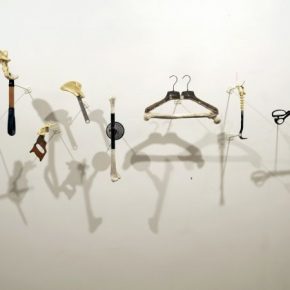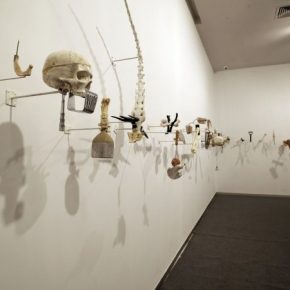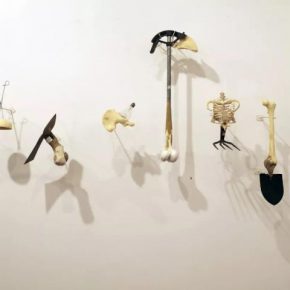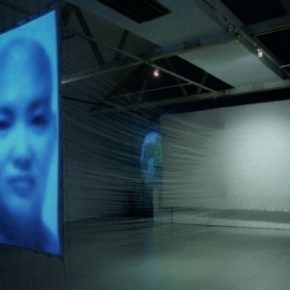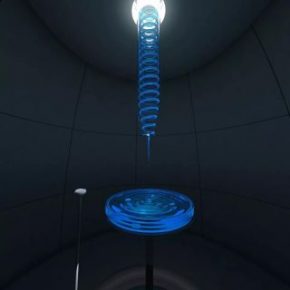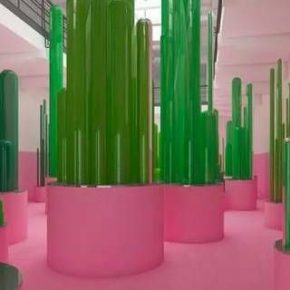
From June 26 to August 26, 2018, the Rockbund Art Museum will proudly host Systems, the first solo thematic exhibition in Shanghai by the artist Lin Tianmiao, curated by Alexandra Munroe, the Samsung Senior Curator, Asian Art and Senior Advisor, Global Arts, at the Solomon R. Guggenheim Museum, New York, with Xiaorui Zhu Nowell, Assistant Curator, Asian Art, Solomon R. Guggenheim Museum, New York.
The artist considers the exhibition to be a site-specific project that explores four key concepts: “individual consciousness”, “collective consciousness”, “public consciousness”, and “ultimate consciousness”. With each concept corresponding to a floor in the museum, going from the second floor of the museum all the way to the sixth floor will embark visitors on a psychological and sensorial journey of “consciousness”. Works shown cover representative installation works from her twenty years’ of creative practice, together with several large-scale, interactive installations which the artist has created since 2017 but has never shown to the public. Manuscripts of archival significance will also be exhibited at the same time.
In the early 1990s, as one of the first female Chinese artists tackling installation and video production, Lin Tianmiao continually tried out various creative media. Through materials redolent of the traces and symbolism of feminine life, such as needles, cotton, threads, silk and fabric—materials which she worked over—the artist wrapped everyday objects and enveloped them, thereby also displaying her care for and reflections about everyday life and traditional handicrafts. With such exceptional imagination and perspective, she formed a distinctive, sensitive, and exquisite personal style. From early works such as Day Dreamer, High! and Loss and Gain, visitors can easily become aware of the value the artist places on material and method, as well as an artistic practice filled with manual tactility and the warmth of life. In 2017, after twenty years of creative practice, she broke away from the traditional media she had used, instead choosing glass—a manmade material widely used in modern life—in order to take on challenges never tackled before. Lin Tianmiao started collaborating with the Shanghai Museum of Glass; from the first stages of grasping the peculiarities of glass, to investigating artisanal techniques, and then to dealing with such scientific terms as “mechanical” motion (among others) as experimentation in installation, she sought out a balance between science & technology and art, involving a richer and more multifaceted exploration. Precisely because shifts in materials, in creative method, and in visual language frequently occur concurrently, visitors familiar with Lin Tianmiao’s work will thus gain an all-new experience of her oeuvre.
Entitled Systems, the concept originated in the system of the human body, starting from a diverse range of modern critique, political theory, and contemporary psychology. As the consulting curator Alexandra Munroe said, “Lin creates or poses ‘systems’ that examine, expose and reimagine the workings of the self in relation to shifting social and technological realities. These systems function on a physical as well as allegorical, even poetic, level. Throughout her immersive work in all media, the human body is her central concern.”
The catalogue designed and produced for this exhibition will be a continuation of the research in the exhibition, bringing together research archives, selected texts, and exhibition images. As an integral text of Lin Tianmiao’s solo exhibition Systems, this also grants viewers a trajectory of reading different from that of an exhibition. At the same time, a series of public education events will take place during the exhibition, further exploring themes related to Systems.
The Journey of “Consciousness”
As the opening chapter of the exhibition, the second-floor exhibition space has a brand-new large-scale installation Response in the middle. Visitors need to walk into the middle of the exhibition space, entering the white “cave” of a futuristic spatial installation whereby one is located within the interior space of the artist’s work, and where a personalized series of experiences and perception commences. One places one’s wrist on the sensor for 5 to 10 seconds, which then gathers the frequency of the pulse; then a blue fluorescent liquid will gradually drip down the glass tubes under the spiral plate. Within a short time, viewers can see, sense, and hear their own “blood” in motion. This exploration is also a one-to-one reaction between the individual and the machine, involving the real self and the false self encountering one another in a set environment; this encounter becomes the process of gazing, perceiving, understanding, distinguishing and questioning the authenticity of self-consciousness. Trying to make the actual self accept the subconscious self, the subconscious thus becomes objective consciousness. Thereafter, the objective consciousness returns to the different stages of the unconsciousness: Reaction—Simulation—Look—Copy.
Separated only by one wall is Lin Tianmiao’s representative work Day Dream, created at the turn of the millennium, a work which primarily employs white cotten thread, the cheapest and most common of materials. On the floor is a mattress hanging in the air, above which is a canvas as big as the mattress; the mattress and the canvas are connected by countless vertical strands of white cotton. The fabric on the surface of the mattress is pulled upwards, with a protruding shape as though escaping from space. Under the illusion of lighting, the interwoven cotten strands—faintly highlighting a sketched human figure—constitute the artist’s deconstruction of her own image in an exploration of the formation of self-identity. The strong visual tension reminds one of the incredibly large-scale manual labour involved in its production.
The third-floor exhibition hall will present her new work, Warm Currents, a work connected to people’s collective consciousness, daily experiences, and modes of living. In using glass vessels of varying shapes and sizes as found in chemistry labs, an utterly unique structure is produced; this structure is connected to a large disk erected vertically on the walls. The pink fluorescent liquid, symbolizing life itself, “rotates” in this glass instrument which is interconnected within, while the representative of large-scale social and cultural machinery “revolves” in the opposite direction, creating the relation of the universe “revolving” and “rotating”, which are mutually reliant. Another important early work, the video installation High!, meanwhile takes on a completely different form of visual experience and presentation.The screen broadcasts a video clip which begins to demonstrate a modern woman’s dynamic profile in color; as her image changes, the image gradually turns static, becoming black and white. Nearly ten thousand cotton threads connect the screen and the canvas, while continually alternating high and low frequency vibrations are transmitted between the cotton strands and the images, along with color images from female portraits turning into black-and-white androgynous images. With the transformations in the video, the sound rises from a sonorous bass to a piercing high pitch; the experience going from the immense to the very fine and sensitive are sent forth in sound and images at once.
The large-scale installation My Garden, specially commissioned for this exhibition, will take up the entire fourth floor of the museum. Borrowing from the concept of public consciousness—“making the real is false, making the false as real”—visitors are invited to take part in a Greenhouse (Garden) made of glass vessels. One is left with the sensation that one is absorbed in a spectacular structure imbued with the art of natural gardening, science and technology, and a daring artistic imagination. Here, the entire floor is covered by a soft pink carpet; in pink vases of varying diameters and height stand glass tubes that resemble vegetation, and inside these glass tubes various sorts of transparent green liquids are sprayed. Visitors can distinguish the plants’ non-scientific names from the words printed on the glass tube.
Loss and Gain on the fifth floor is the highlight of this exhibition: from the individual, the collective, the public, to the ultimate “consciousness” being presented, the artist has calibrated the humorous points of commonality between skeletons and tools. Everyday tools originally have their specific functions and attributes; when tools and bodily skeletons are “married”, their functions and attributes are recombined, seemingly accidentally extending the serious issue of death towards the production of a new consciousness. As visitors reach the sixth floor, wrapping up their journey of “consciousness”, they will see in the central atrium manuscripts created by Lin Tianmiao. Whether perspectival images, cross-section images, or blueprints, each manuscript is considered with a meticulousness much like the production of an engineering blueprint; each reflects the historic process of the artist’s creative thinking.
About the artist
Lin Tianmiao was born in 1961 in Taiyuan, China. She now lives and works in Beijing, China.
Lin Tianmiao studied in the Fine Art department of Capital Normal University, Beijing in 1984. She then went to the US in 1988. After graduating from the Art Students League in New York in 1989, she worked as a designer in New York for almost seven years. In 1995, Lin Tianmiao returned to China from New York. ?Presenting The Temptation of St. Teresa, The Proliferation of Thread Winding, Pants, Trees, among others in an open studio, she thus laid out the important positions of her engagement in experimental art; during the same time, she became known as one of the first Chinese female artists to gain international recognition. During the 1990s, when “apartment art” was a phenomenon in Beijing and Shanghai, Lin gained a great deal of experience. Lin’s early works are known for her practice of thread-winding where she binds the material—usually silk, hair, cotton, or felt—tightly around found and manufactured objects. Initially tasked by her mother to spool cotton as a young girl, Lin later reclaimed this act. Lin’s work studies her own social role and the relationship between identity and social context, questioning women’s identity. In 1998, Lin and Wang Gongxin created the Loft Media Center. She had done everything from infrastructure and interior decoration to design, supervision, equipment management, organization, etc. It laid the foundation for holding hundreds of cultural events in the future. In 2012, the Asia Society Museum in New York presented Bound Unbound, the artist’s first major solo museum exhibition in the U.S.
About the Curator
Alexandra Munroe, PhD, Samsung Senior Curator, Asian Art, and Senior Advisor, Global Arts, Solomon R. Guggenheim Museum, is a pioneering authority on modern and contemporary Asian art and transnational art studies. She has led the Guggenheim's Asian art program since its founding in 2006 while also working on the Guggenheim Abu Dhabi Museum and the Guggenheim UBS MAP Global Art Initiative. She convenes the museum’s biannual Asian Art Council, a curatorial think tank, and directs The Robert H. N. Ho Family Foundation initiative in contemporary Chinese art.
Munroe has organized many award-winning and critically acclaimed exhibitions that have promoted international scholarship and recognition on modern and contemporary Asian art. She is recognized for launching the international critical appraisal of artists Cai Guo Qiang, Daido Moriyama, Yayoi Kusama, Lee Ufan, Mu Xin, and Yoko Ono, among others, and for bringing such historic avant-garde movements as Gutai, Mono-ha, Korean Tanseakwa and most recently, Chinese conceptual art, to international attention.
Raised in Japan, Munroe was former Vice President of Japan Society, New York, and former director of its museum. She holds an MA from the Institute of Fine Arts, New York University, and a Ph.D. in History from New York University. She serves on the advisory boards of Rockbund Art Museum, Shanghai and is a trustee of the Institute of Fine Arts, New York University. She is a member of the Council on Foreign Relations, New York.
About the exhibition
Dates: Jun 26, 2018 - Aug 26, 2018
Venue: Rockbund Art Museum
Courtesy of the artist and Rockbund Art Museum, for further information please visit www.rockbundartmuseum.org.


